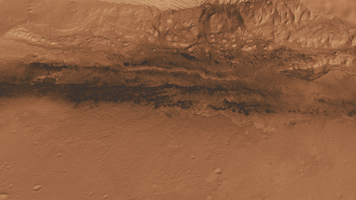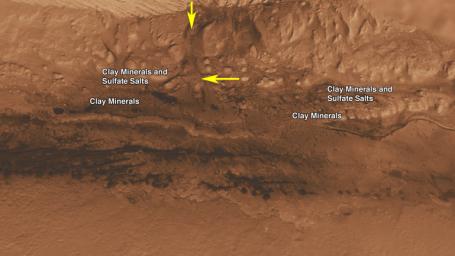
Unannotated image
Click on the image for larger viewThis oblique view of the lower mound in Gale crater on Mars shows an area of top scientific interest for the Mars Science Laboratory mission.
This area is at the base of the mound, just beyond a dark dune field. Here, orbiting instruments have detected signatures of both clay minerals and sulfate salts (see labels on image). Scientists studying Mars have several important hypotheses about how these minerals reflect changes in the Martian environment, particularly changes in the amount of water on the surface of Mars. The Mars Science Laboratory rover, Curiosity, will use its full instrument suite to study these minerals and how they formed to give us insights into those ancient Martian environments. These rocks are also a prime target in checking for organic molecules since these environments may have been habitable -- able to support microbial life.
A canyon was cut in the mound through the layers containing clay minerals and sulfate salts after deposition of the layers (marked by arrow). This canyon, much like the Grand Canyon in Arizona, exposes layers of rock representing tens or hundreds of millions of years of environmental change. Curiosity may be able to investigate these layers, gaining access to a long history of environmental change on Mars.
The canyon also contains sediment that was transported by the water that cut the canyon. This sediment interacted with the water, and the environment at that time may have been habitable. Thus, the rocks deposited at the mouth of the canyon form the third target in the search for organic molecules (marked by arrow).
This three dimensional perspective view was created using visible-light imaging by the High Resolution Imaging Science Experiment camera on NASA's Mars Reconnaissance Orbiter and the High Resolution Stereo Camera on the European Space Agency's Mars Express orbiter. Three-dimensional information was derived by stereo analysis of image pairs. The vertical dimension is not exaggerated. Color information is derived from color imaging of portions of the scene by the High Resolution Imaging Science Experiment camera.
The Mars Science Laboratory spacecraft is being prepared for launch during the period Nov. 25 to Dec. 18, 2011. In a prime mission lasting one Martian year -- nearly two Earth years -- after landing, researchers will use the rover's tools to study whether the landing region has had environmental conditions favorable for supporting microbial life and for preserving clues about whether life existed.
NASA's Jet Propulsion Laboratory, a division of the California Institute of Technology in Pasadena, manages the Mars Science Laboratory and Mars Reconnaissance Orbiter projects for NASA's Science Mission Directorate in Washington.
The University of Arizona, Tucson, operates the High Resolution Science Imaging Experiment. The European Space Operations Centre in Darmstadt, Germany, operates the European Space Agency's Mars Express mission. The High Resolution Stereo Camera was developed by a group with leadership at the Freie Universitat Berlin.

 Planetary Data System
Planetary Data System













